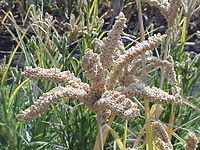
Photo from wikipedia
Phenotyping and genetic assessment of germplasm provide information about trait variability, which helps for effective breeding programs. In the present study, 12 indigenous finger millet genotypes from Koraput, India and… Click to show full abstract
Phenotyping and genetic assessment of germplasm provide information about trait variability, which helps for effective breeding programs. In the present study, 12 indigenous finger millet genotypes from Koraput, India and three high-yielding improved genotypes were used for elucidation of genotypic variability of photosynthetic traits and genetic diversity using 36 SCoT (Start codon targeted polymorphism) markers. Significant variations were noticed in the CO 2 photosynthetic rate (P N ), stomatal conductance (g s ), transpiration rate (E), internal CO 2 concentration (Ci), water use efficiency and carboxylation efficiency among the genotypes. Significant variations of stomatal traits, pigment content, PS II activity and dry matter accumulation were also observed. The major morpho-physiological traits such as stomatal conductance, dry matter accumulation, shoot length and stomata per leaf area are played a pivotal role and are the major determinants of phenotypic diversity. The positive association of photosynthesis with dry matter accumulation indicates that some of the genotypes remarkably have more photosynthetic rate along with better plant biomass accumulation and can be used in future crop improvement program. Further, SCoT markers were polymorphic and revealed moderately high level of genetic diversity and provided information on population structure among the finger millet genotypes. The SCoT primers, SCoT-14, SCoT-18 SCoT-20 and SCoT-23 showed the higher PIC value and marker index, and potentiality for exploring the genetic diversity of studied millet genotypes. Based on the genetic similarity analysis it is revealed that some of the indigenous finger millet genotypes such as Jhana , Lala , Kurkuti , Ladu , Bhadi and Taya showed highest genetic disimilarity with modern high yielding genotype and can be considered as the potential genetic resources for breeding program.
Journal Title: Journal of Plant Biochemistry and Biotechnology
Year Published: 2020
Link to full text (if available)
Share on Social Media: Sign Up to like & get
recommendations!